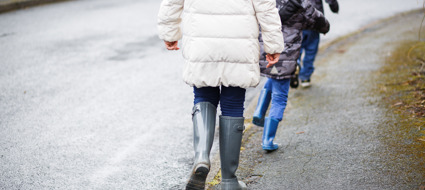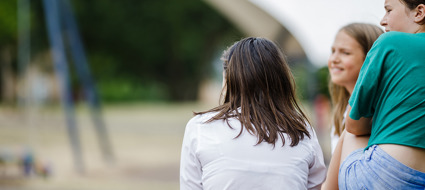Safeguarding children and young people from exploitation
Published:
Working to enable an effective safeguarding response for children and young people who are, or are at risk of, being exploited.
Lead author Carlene Firmin, University of Bedfordshire and Research in Practice Director Dez Holmes discuss the Safeguarding and exploitation – complex, contextual and holistic approaches: Strategic Briefing. They reflect on the holistic approach needed to protect children and young people who are, or who are at risk of, being exploited.
The current system is arguably not designed to meet the needs and risks that young people face outside the family home. They explain the rationale behind complex, contextual, transitional and holistic safeguarding approaches and how they overlap and complement each other.
Looking at a case example, they outline how the child protection system needs to adapt strategically and operationally in order to respond to the harm that this young person faced. They also discuss the importance of working with parents as partners and the need to work with communities to enable an effective safeguarding response for young people facing harm outside of the home.
[Introduction]
The research and practice podcast, supporting evidence-informed practice with children and families.
Dez: So, I'm here today with Carlene Firmin, who's the head of the contextual safeguarding programme at the University of Bedfordshire. Hi, Carlene.
Carlene: Hi, Dez.
[Defining complex, contextual and holistic safeguarding]
Dez: And Carlene and her colleagues have written our most recent briefing, which is for strategic managers and explains the different ways in which exploitation and safeguarding, particularly in the context of complex, contextual and holistic approaches, can play out. So thank you very much. That is a lovely bit of work. So, briefly, do you want to just explain to the listeners what we mean by complex contextual and holistic approaches, when we're talking about safeguarding and exploitation?
Carlene: Briefing is a good term to start with, Dez, so briefly I will explain. So, when we talk about complex, really what we're doing is thinking about the additional considerations that we'd have to make when working with, A) teenagers, young people during adolescence, and the different types of experiences that they may have compared to more intra-familial forms of child abuse that we are more used to working with. So, we're not talking about physical abuse, for example. We may be, be talking about criminal exploitation, sexual exploitation. How do we respond to those issues and how do we work with young people, and parents as partners, in our response to those issues? Engaging with the particular dynamics of adolescence that we often see as challenges but we would hope we could see as opportunities in terms of young people's choice making and their role in, kind of, working alongside us to create safety, and seeing parents as part of that as well. Contextual really focuses on the additional contexts that young people may be vulnerable in as they move through adolescence. So, in earlier childhood, we would predominantly be focused on the family home although not exclusively, obviously we'd need to think about their safety in school and other settings, nurseries. But as young people move through adolescence and spend more time independently of parental supervision, and socialising in spaces and places within their communities, in neighbourhood settings, online settings, with their peers and in educational settings, the nature of those contexts needs to considered when we're thinking about how we keep young people safe. And we know a number of risks that young people experience during adolescence will play out in those extra-familial contexts.
So, contextual really is thinking about how we engage with those contexts. And holistic really is making reference to the fact that what we have seen in recent years is differing attention being paid to particular forms of extra-familial risk or different forms of exploitation. So, there may be a focus on child sexual exploitation. Currently, there's a focus on criminal exploitation. There's also been a focus on radicalisation, for example. And what we've tended to do is to split those, so we have our response to sexual exploitation, and we have our response to criminal exploitation, and to gangs, and youth violence. And what we're seeing more and more is the need to offer a holistic response to all of those issues because despite their many differences, and there are differences between those forms of abuse and the way they're experienced, and in the factors we need to consider, there are also some key identifying features but also key challenges that we face in trying to respond to them. And it's thinking about how do we address those key challenges, those fundamentals, that we want to see develop more in a holistic approach? Really to bring it to light I would say think about trying to respond to physical abuse experienced by children, sexual abuse experienced by children, neglect experienced by children, emotional abuse experienced by children, without a child protection system. So, we've just developed a response to physical abuse, just sitting of in this ether. It sits completely separate to any response we might have to emotional abuse, even though we know that they often intersect for young people and we have a wider system that is equipped to respond to all forms of abuse.
What we've had to do then, build up specialism in the nature of those different forms of abuse and how they affect young people. But we haven't built that specialism in a vacuum, it sits within a more holistic response to child abuse and that's what we need to see for exploitation as well.
Dez: And I think we see some of that fragmentation you describe, partly driven by service design but also partly driven by funding patterns, and even driven, perhaps, by where political attention is focused at a particular time.
Carlene: Absolutely.
Dez: So, you know, I know that in many local areas, they have a CSE (Child Sexual Exploitation) team which is separate from their gangs team, and then they have another specialist county lines team, and then somewhere in a very different part of the building, there's some specialists working around neglect. We know, of course, for many adolescents, not only adolescents, I know this can affect younger children, they might be experiencing all of those things or be experiencing some of them and at risk of others.
Carlene: Absolutely.
Dez: So, we haven't created a holistic system.
Carlene: No.
Dez: And I guess that part of the complexity comes, and you highlighted it earlier, in that whilst it can feel like a nice, neat delineation to have intra-familial harm affecting younger children and extra-familial harm affecting older children, we also know there's sometimes a read across. You know, we've talked about this before, haven't we? Many parents are absolutely protective of their older children and are doing their best to keep them safe, and need to be treated as partners in that safeguarding approach and that agenda. And we also know that sometimes, intra-familial factors can exacerbate risk and vulnerability for older children. So, that, I guess, is where the real complexity comes and I know that when we have worked in local areas, one of the key things is getting practitioners to hold on to the fact that it's both and not either or. So, trying to do away with some of the false neatness that we find.
Carlene: Absolutely, absolutely.
Dez: Some of the challenge here is that our existing frameworks, if you like, our traditional child protection system, wasn't designed with these complex contemporary adolescent risks in mind and I'm sometimes quite struck by the sense that the purpose has outgrown the design. And that, of course, created quite a lot of discomfort in the sector. Is that something that would resonate with you in your work?
Carlene: Yes, absolutely. I think where we have really struggled is that we recognise, and rightly so, that issues such as criminal exploitation or sexual exploitation are abuse. And they are experienced as forms of abuse and children have a right to be protected from them and the state should intervene. And that's what we've, kind of, ended up in the situation is, we've just said that they're forms of child abuse and then assumed that, therefore, the child abuse structures and systems that we have in place will respond to them as forms of child abuse without recognising that actually, the system was only really every intended to respond to specific forms of child abuse. And that's really where we've come short. And it's not just in practice, it runs through our policy frameworks. When we really look at our guidelines, and we really look at our policies that we draw upon to develop our systems, there is constant reference to the need to assess and intervene with families, with the child and family. What is going on in that family? How can we build up the capacity of that family to be more protective for that child? There is hardly any reference at all to peers, for example, as a significant relationship that we should be working with.
Dez: Which is extraordinary, really, when you think that most conservative estimates would suggest that a third of all child sexual abuse is actually instigated by other children, and yet we don't actually have a statutory definition for harmful sexual behaviour. So, we can, kind of, see that our gaze has been focused in certain areas, notwithstanding the evidence of whether that form of harm is particularly prevalent.
Carlene: Yes, absolutely. And so what we've seen then is a, kind of, shoehorning sometimes of our responses to these more complex issues, into a system that wasn't designed for them. So, we see parents on child protection plans for neglect, then when you drill down, yes, there may be more that the parents could do, maybe in some of these cases, obviously, but if we remove the fact that there's an organised crime group exploiting that child, would the behaviour of those parents warrant a child protection plan? Probably not in a number of these cases. We need to think about the interplay between what the parents are doing and what the risk is, and what we can sometimes see is that there's a risk of significant harm outside of the family, and you've got a family in need of support or in need of some early help. But because of the risk of significant harm, we actually respond to the family as being a cause of significant harm and that becomes a real problem for us. A) it isolates the parents but, B) it actually doesn't necessarily reduce the risk because you can do work with parents, and we do do work with parents where that work is needed, but simply equipping parents to install more boundaries will not remove a drug debt that's hanging over the head of a young person. Or remove the threat that they've received that their house will be set on fire if they don't attend this party house where they're going to be sexually assaulted. So, we really need to think about whether the place we have in place for that family and child is actually going to reduce the risk of significant harm. And just focusing in parents, in most of these cases, will not reduce the risk of significant harm. It may increase the protective nature of the family but that, in and of itself, won't necessarily safeguard young people from exploitation.
Dez: And I've heard, I've got lots of sympathy for those who argue that when we talk about parental capacity to change and family safety, we really mean mothers.
Carlene: Absolutely.
Dez: And Brid Featherstone and others have written at length about this, that there is a punitive nature, particularly around issues of neglect but other forms of child maltreatment, where really, we are seeking to change mum's behaviour, mum's "choices." And, information act, our understanding of parental capacity to change is often, sort of, understood through a lens of intrinsic capabilities. If mum, often mum, not exclusively, if mum would just leave this person who presents as violent, if mum would address her mental health difficulties, if mum could overcome her substance misuse, but actually, in the context of, you know, many of these complex, contemporary harms facing adolescents in particular, the parent's capacity is undermined by extrinsic factors, by organised criminal gangs, by those who are extremely adept at targeting children and exploiting them.
Carlene: Yes, absolutely. And even when we think about children who are being exploited by peers, you know, when I've reviewed cases of… for example, there was one young woman I reviewed a case of who was being sexually exploited by a group of fourteen, fifteen year olds when she was thirteen, and that was happening at school and in the community setting. Now, there were challenges at home and she had already been known to social care for those challenges and support was going in to place. There was very little that her mother and grandmother could do to prevent her from being sexually exploited at school, apart from stop sending her there. I mean, that was literally all that could happen. We really needed to think about what the role could be of the school leadership in that case, and pastoral care in the school, and work with the young people who were actually exploiting her, and that work not just being framed as, well, the police are proceeding or not but what do we do regardless of a criminal investigation to create healthier and safer relationships between young people in that school setting? That really needed to be the focus but because of the system that we operate in, the school was not the focus. The peer group was not the focus. It was her mother and grandmother, and what they could do to keep her safer when she was at school.
Dez: So, we have a system that wasn't designed for the needs and risks that people face, and then practitioners often working within that system who, I think it would be fair to say, often become quite demoralised and feel very frustrated because they can recognise, if you like, the tools they've got aren't always fit for the job in hand. And a real complexity, I think, it's a personal view, I sometimes wonder whether we just like simplicity, we like the idea that there are goodies and baddies, and victims and villains, and children and adults, and that there's a really hard and fast line between those. When, of course, we know this stuff is riddled with complexity, children having dual identities as both victim and perpetrator of harm, parents being both protective and being, perhaps, a form or a source of need and exacerbated vulnerability. And I do sometimes wonder whether part of the issue here is cultural and psychosocial.
Carlene: Yes, absolutely. And I think that really does speak to why we really should be moving towards the direction of holistic approaches where we try our best not to create full separations between victims or perpetrators, or different experiences and issues, because that's not how they're lived and we make it worse for ourselves and much harder for ourselves when insist on creating these derides.
Dez: Yes, it's false neatness. So, this briefing, then, that you and your team have authored for Research in Practice is really, timely, it really sets out some of these key issues. And I know that when we talked about planning it, we were really keen that it would, sort of, help senior managers think about the need for strategic redesign. Do you want to offer reflections, what was it like writing the briefing? How did you find it? Do you feel that you fulfilled what you set out to do?
Carlene: It was a really enjoyable briefing to work on with the team because, while when we've been doing training and presentations, we've had to increasingly speak to the intersection between different forms of exploitation and what this means for practice responses. Sitting down and thinking 'how do you communicate that on paper rather than in person?' was a good challenge to have. And really, also forcing us to think about where these forms of exploitation may intersect, both in how they're experienced and how they're responded to, and what that could mean for how we strategically enhance or advance our, kind of, set up of our services and the way we support practice. So, what we've hoped to have done with the briefing is really enable local areas to think about how they can progress their work, drawing upon some examples of practice from around the country but also thinking about things like, 'Do we have a system that is equipped to respond to grooming in all its forms?' Rather than, 'Do we have a system that's equipped to respond to criminal exploitation versus CSE, versus radicalisation, and so on and so forth?' Because, actually, whether or not we can engage with the impacts of grooming and a young person's insistence that this is their choice, is more important than the specific context in which that choice is being framed or made. And we see this tension now playing out with criminal exploitation because we thought we'd sorted that argument. We thought, 'Yes, absolutely, you can't, kind of, engage in any victim-blaming behaviour, a young person cannot choose to be abused, we shouldn't be doing this and we're not going to do it anymore for sexual exploitation.' And obviously, we still have some areas in practice but we also see improvement.
[Shifting language beyond victim blaming]
Yet, when we look at criminal exploitation, we see the same language being used, they're making lifestyle choices, they're refusing to engage with us. Hang on a minute, I thought we'd already bottomed that out? This is what happens when you say we can respond to an issue rather than the challenge that issue presents.
Dez: Absolutely, it's about not seeing the child behind the presenting behaviour. I think that point about not transferring our learning from sexual exploitation is really well made. We are seeing very many examples where children who are affected by criminal exploitation are being talked about as if we have learnt nothing in the past decade. 'He puts himself at risk.'
Carlene: Yes, absolutely.
Dez: And I think that even within sexual exploitation, I wonder sometimes whether we've seen a shifting of language, but now we're just codifying and the same intent is there. So, whilst, you know, many professionals, if not all, have stopped using words like promiscuous about victims of sexual exploitations, I wonder how different the meaning is behind sanitised language like, 'Risky behaviours or risk-taking adolescents.' There's still an inference that we can locate blame, and choice, and rationality in the person being harmed. So, I'm a bit cautious of, you know, you can sometimes feel that you're reading a document and you can almost see the Tipp-Ex, and all the meaning in the sentence making is still there, we've just changed a couple of words and that dispirits me sometimes.
Carlene: Absolutely. I think any kind of terminology that individualises these very social problems is going to get us in a sticky situation over time, because it doesn't shift the cultural framing of those issues, it just makes it a bit more comfortable for people. And, really, this work isn't comfortable. We should feel that discomfort because it's a highly challenging field to work in, it's not easy and the hard that is done to children is severe. So, we should feel discomfort, we should be challenging ourselves. If it feels like we're not having to critically think about how we're engaging with a situation and we're just, kind of, responding using the words that we know we should, then we're probably not utilising our skill set to actually provide a young person with the response they need.
Dez: I totally agree and I think, reflecting on your point there about how if we focus on the issue and not the commonalities, one example that always springs to mind is that adolescence attachment needs and their need for belonging. Whilst there's certainly not a neat cause or pathway into these different forms of exploitation, one of the common factors that comes up quite often is the young person's attachment needs, their desire to belong, their need for intimacy, their absolutely reasonable human need for intimacy. And that some forms, or manifestations, of both criminal and sexual exploitation, and arguably some forms of radicalisation, although the research is…
Carlene: No, it's not there.
Dez: Not there yet, so we should be cautious, there is a sense that we as a system are not meeting those attachment needs and so others are. And yet, very rarely do I hear a really sharp focus on adolescent attachment in the way you do in early years services, for example. So, we're getting better at addressing the presenting risk of sexual exploitation, or the presenting risk of a young person affected by gangs, we're not, as a whole system, gearing up to think about a young persons need for belonging.
Carlene: No, absolutely. And working with the grain of adolescence across all of those factors, so what we see is this young person who is taking risks, which is a phrase that I struggle with but that's what we hear. A young person who is only really motivated for the weekend instead of the five years that we want them to be able to visualise. A young person who is happy one minute, sad the next, immediately attached to somebody we don't want them to be and feeling this intense connection with them and then falling out with that person and feeling like it's the worst thing that's ever happened them. And wanting to make all these decision on their own without our input at all. And when that encounters the system that we have, that's just a big problem for us and we can then load the problem on the child. 'They won't engage with us,' you know, 'They are making these choices, they are problematic, they are making lifestyle choices, continuing to put themselves at risk,' that's how we then engage. And what's even more concerning with that whole, kind of, narrative, is that this presentation that we struggle with so much, is also a dream for anyone that wants to exploit a child. So, we make it doubly hard for ourselves and easier for them because they will provide those thrills and risks, and they will provide that emotional, kind of, intensity that that young person may be experiencing and recognising its authenticity, and not say that it doesn't really mean anything, and they will provide them with gains for the weekend and tell them not to worry about five years. You know, they will enable them to perceive that they are making choices for themselves, and that, 'No people would understand you but I believe in you, you're making the right decisions.' So, they actually work with the grain of adolescence, we push against it and we lose.
[Service and system design]
Dez: Absolutely. I think that's a really, really important point that is sometimes overlooked, that when we’re talking about service and system design, and practice models, we need to recognise that those who seek to harm our kids are much more attuned to adolescent development then we are. Unlike us, they don't have thresholds, they don't gate-keep their resources, they don't have age limits, they don't walk away at eighteen, we do. They are there for our kids before we get there and long after we've gone. And they are able to, I would suggest they're able to identify vulnerability and target it much more effectively than any system we have, professionally.
Carlene: Absolutely. Now, I would also say, obviously, they're based in the context that we struggle to reach. So, we're busy focusing solely, really, on parenting, and they, kind of, work with that distancing of parenting and actually, locate themselves in online spaces, on high streets, in shopping centres infiltrate our education systems, through young people that we're already isolating and marginalising through exclusions. And can be present for young people in those spaces.
Dez: And actually, we feed that sense of isolation, isolation is an important word here. Some of the system and service responses to adolescent risk and harm, we might, if we were tough on ourselves, recognise that they are further isolating. So, I often think of Karen Treisman's words when she talks about how relational harm requires relational repair. And yet, too often, the responses we offer to young people facing risk are relational severance. We'll move you out of home, we'll remove you from your school, we'll put you in a different community, we'll put you in an isolation booth because you're just too naughty, we'll move you out of area, we'll put you in 23 hours a day lock-up. So, we are actually creating greater isolation and exacerbating those really primal needs that young people might have, which then, people who seek to harm them, can exploit.
Carlene: And all I think we have to do is recognise the professional anxiety that sits underneath those decisions because, you know, I completely understand and recognise that fear that if I don't remove that child, or I don't separate them from those people, that I might not see that child again, or they were missing for six weeks last time and I don't know when they'll come back. I don't want that on my conscience, let alone on my professional record. I don't want that. And when we fixate on the fact that we have to be seen to do something, rather than think, 'Is this going to be the thing that actually creates safety for that young person?' We see that real focus on the physical safety of that young person, and to draw upon the work of Lucie Shuker and others, a real lack of attention to the relational safety that that child may have access to where they are. And the psychological safety, that we need to try to preserve for that young person.
[Transitional Safeguarding]
Dez: I would say there's actually a fourth lens to consider, which is around their developmental safety. I mean, too often, and this comes up a lot in local areas where they describe children's services for very understandable reasons, for feeling they've run out of options, and identifying, you know, usually quite a high cost and often out of area, provision for a young person. A very secure provision in many cases. And that provision not meeting their relational and psychological needs and not meeting their developmental needs, primarily because, of course, when that young person turns eighteen, adult services, again understandably, take one look at that care package and say, 'We can't and won't fund this. This young person is not believed to lack capacity now they're over eighteen. There is no justification for us keeping them in this place, this provision, often far from home.' And so then, too many young people return to their communities, having not been equipped, not being skilled up, not having had good transition planning, and they're back in the same neighbourhood where they were facing risk just a few months or years earlier.
Carlene: Absolutely, which is why, in the briefing, we also discuss transitional safeguarding as part of this holistic and complex response to safeguarding and exploitation. We really cannot be stifled by these artificial, kind of, boundaries that we've put in place around our services and, particularly, at least thinking up to 25. And what we don't want is then to create a cliff edge at 25. So, the transition process is really important and I've heard you talk very clearly about the need for that, kind of, ramp or slope, so that we've got a process rather than a cliff edge. And I think we really do need to think about that but absolutely thinking about beyond eighteen and not stopping there is going to be critical for these issues. And what we're hoping is some of the approaches that we flag in the briefing are ones that don't only apply to those under eighteen, and actually, if we do them well, they should start to leverage a response that is more holistic across these age boundaries.
Dez: Talk us through the flow of the briefing then, for any listeners who haven't yet read it.
Carlene: Sure, so the way we've tried to structure the briefing is to first, kind of, introduce the nature of exploitation, talk about the definitions and particularly the intersections between different forms of exploitation and what they share in common. Albeit, acknowledging their differences. Before then, kind of, highlighting some of the strategic challenges that are posed by the national frameworks that we're working with and I think that's really important to put out. We recognise there isn't a national strategy on exploitation, there isn't a national strategy on adolescence, so we are asking areas to do something that we're not being given leadership on at the moment, and when there is not a, kind of, direction of travel that sits across the country. So, we have to think about how we work within that deficit that we currently have. Before, kind of, outlining some key considerations for developing more effective responses that are holistic, do address conditional issues and do provide a more holistic response. Drawing upon examples of local practice and also identifying some key terminology such as complex safeguarding, or contextual safeguarding, or transitional safeguarding that we're seeing used more frequently and what they mean in terms of structural redesign, and that they're not interventions, they are system change pieces of work. Before thinking about what strategic leaders might want to consider as actions to take to enable a workforce to begin to, kind of, move in this direction of practice.
Dez: And we deliberately focus on strategic managers for this briefing. I mean, I guess to state the obvious, because it was within their gift to change the system and the services, whereas practitioners can only work within the systems and services they exist in.
Carlene: Yes, absolutely. It's really interesting because we often get asked to do training on these issues and we are then faced with front-line practitioners, we do a day's training with them and they feel very enthusiastic about what we're presenting but also anxious about whether or not they're actually going to be equipped to do any of the things that they're now wanting to do. Wanting to know, 'Is this a position of management? Is there going to be a move in this direction?' So, it's really important, I think, for strategic leaders to engage in this conversation and think, 'Are the systems, structures, commissioning decisions, training offers we've got in place going to enable to workforce to move in this direction?'
[Complex Safeguarding in Greater Manchester]
Dez: Now, we've touched on terminology there, and I know that both you and I are huge fans of the colleagues in Greater Manchester. So, the term complex safeguarding, although it can mean many different things to many people, it was coined in Greater Manchester, I guess because colleagues there were really keen to recognise and work with some of the commonalities. Now, they define complex safeguarding as being, 'Criminal behaviour or behaviours associated with criminality where there is exploitation and where children's safety is compromised.' And they've gone for a structural solution to that, they've actually revamped how their services work.
Carlene: Yes. So, they have got, kind of, complex safeguarding hubs that specifically work with these issues and bring professionals together, co-located around these intersecting issues rather than issue specific hubs. They also are drawing upon learning from their innovation work around working with young people as partners in developing alternative type safeguarding plans, and achieving change together plans, where they're thinking about how can they work alongside the young person, then the parent to reduce risks of exploitation? So, it is thinking about how these risks intersect, building an expertise and a hub around these intersecting risks, but also enabling the workforce to actually engage with the nature of adolescence as they respond to those issues.
[What we mean by Contextual Safeguarding]
Dez: Yes, you're quite right, Carlene. Their complex safeguarding work has drawn on learning from the achieving change together project that was run in Wigan and Rochdale, funded by the DfE social care innovation project, and listeners who want to find out more about that particular piece of work can see the evaluation on the social care innovation programme website. So, now, sticking with the them of terminology, you are the head of the contextual safeguarding programme. You basically invented it and I was going to introduce you as queen of contextual safeguarding but that's not your official job title, does it frustrate you as much as it concerns me that people are using the term contextual safeguarding when they don't necessarily mean it? Or they are confused about what it means?
Carlene: Yes. I mean, it's concerning, I'd say, because what we're hoping is that it is a term that will describe an approach to assist people in developing their practice, so it is really important, particularly at this juncture where we do see it in statutory guidance but do see it as something that we in the process of developing and testing. That the term is not diluted or used in other ways, to the point that it becomes unrecognisable because we want it to be helpful. I completely understand how this has happened. Obviously, in working together, the term contextual safeguarding features above a paragraph on extra-familial risk. So, in some occasions, it's being used as shorthand for all risks that we'd associate with being outside of the family. So, I guess the first thing to say is contextual safeguarding is not a risk and it's not a shorthand for different types of risks. It is an approached practice, so we wouldn't encourage the use of the term to describe issues.
Dez: So, that's important. Contextual safeguarding is a verb and not a noun?
Carlene: Indeed, that's the first thing. The second thing is that it is a particular approach to responding to extra-familial risk, and to responding to the context in which that risk occurs. So, for an area, say they're doing contextual safeguarding, doing contextual safeguarding is not responding to extra-familial risk, a lot of areas respond to extra-familial risk in different ways. Some areas are developing a contextual safeguarding response to extra-familial risk. And to think about whether or not you're doing that, we have helpfully now published a full implementation toolkit, so you can think about the extent to which your implementing the approach. It is a whole systems change approach, it is not an intervention or an add on to a system, it is changing the way the system works, and primarily, equipping a safeguarding partnership and children's social care specifically, to be able to assess and intervene with peer group, school and neighbourhood contexts. So, the system needs to be able to do that, not just recognise those contexts but actually assess and intervene with them.
Dez: And importantly, not only is contextual safeguarding a set of quite defined practices, and tools, and methods, it's being tested through formal research, which you're leading.
Carlene: Absolutely. So, we've been testing it in Hackney, well, I would say developing and testing it in Hackney for two years, because in 2015, it was really just a concept. So, we needed to work with an area to actually bring it to life and that's been a helpful process. We'll now be working with five other local authorities to consider what would that approach look like in their areas, with differing, kind of, operational structures, different budgets, different geographies and demographics? It is very much an approach, not a model so we anticipate it looking very different, achieving different things. And our principle really is to publish as we go, so we are just, as soon as we create something, putting it out there and saying, 'This is what we're trying at the moment, we're not quite sure.' And as we learn, if we start to find that there are particular elements of the toolkit that require significant change, we will amend as go and so on and so forth. So, we are being as transparent as we can but it is absolutely a work in progress. It's not a silver bullet and never will be to anything. And we are keen for areas to get in touch with us if they want to develop the approach, and we can provide some guidance as to how to go about that. And it can be a drip feed process. But for any area that has contacted us so far to ask for assistance, and we are running a long list of areas at the moment, we're saying, 'We're giving it at least three years to be anywhere near doing it. It's not something you can do on a six month task and finish plan.'
Dez: And it's certainly not something you can say you're doing just because you've had a keynote speech at a conference, is it?
Carlene: No, no.
[Families, young people and communities as a part of the solution]
Dez: So, that's a really, really important point about terminology and I know that in the briefing, you try and explain to people how contextual safeguarding, complex safeguarding and the emerging notion of transitional safeguarding, which, similarly, is not a model, nor is it a set of practices. It's really just giving voice to a problem that everybody has known about, which is that harm, nor its effects, stop at eighteen. In the briefing, you try to highlight the role of families and young people themselves, and communities as a part of the solution, do you want to say a couple of words on that?
Carlene: Yes, I think it's really important, as we've already been discussing, first of all, if you think about young people, this is a time in your life where you have an increasing desire for autonomy and decision-making. So, thinking about how we work with that, not battle against it, not try and control young people's choices but actually think about how that's an opportunity to sustain impacts beyond the time that we might have with a young person, is really important. So, we've drawn upon some examples of organisations that are working alongside young people, supporting them to have a voice in multi-agency meetings but also in the design of their plans and in, kind of, the decision-making around their care. So, that's been really important. In terms of parents, we are seeing more support groups for parents being set up, we obviously have some national organisations that we highlight in the briefing, who are working alongside parents and often run by parents, to support them in understanding how the system is responding at the moment, and why that is, and how it could be different. And how they could be seen as partners in, working alongside social workers, police officers, youth workers, and supporting young people to stay safe. We're also seeing some really interesting work in some areas, who are bringing parents together. It's, kind of, quite obvious but bringing parents together to see how they can provide peer support to one another, to support their young people who are a peer group or who are socialising together. Because parenting during adolescence is hard. And what some parents are saying is we just need some recognition of that and some space to voice that and work together. So, it's parents are partners with one another as well as partners with professionals.
And we're then thinking about, obviously, the role of community in all of this, particularly given the public nature of some of these risks, we have to think about the roles that could be played by security staff, bus drivers. We've seen interesting work in Australia working with rubbish collectors in local parks, so a range of different people potentially playing a role in being active community guardians or really engaging in creating safe space for young people.
Dez: And that seems so important because we know that for young people, and for, you know, some children before they reach adolescence, their roots to harm and their roots to protection might be outside of their family context. So, thinking about how communities can be mobilised as a source of protection, as well as recognising that's where hard and risk seems, you know, it's blindingly obvious when you say it. I'm often struck, it might even be one of your examples, perhaps I'm misquoting here but, 'If many of your young people you're worried about are spending their time in a fast food restaurant because that's where the free Wi-Fi is, why is no one in that fast food restaurant getting level one child protection training?' You know, they're certainly not being invited to sit around the local safeguarding partnership table.
Carlene: Yes. And this is why strategic questions need to be answered, because what we're not suggesting, and I would be anxious if it was interpreted as such, is that what we want to just create is this massive influx of referrals from everyone under the sun, who's now got their eyes out for young people and got, you know, the front door on speed dial. And then you're going to have to manage this massive increase in referrals from a range of agencies. But it's actually thinking, 'How do we support those people to identify what their role could be in creating safety for young people where they are?' And obviously, making the referral when it's required but that's not really it. It's about when they're with us, what do we do to create safety here? In fact, we don't need to pick up the phone, actually. And then what are the occasions when we would need to pick up the phone?
Dez: So, this is actually about, kind of, core citizenship values?
Carlene: Yes.
Dez: It's not about creating an influx of requests for statutory help?
Carlene: Yes, absolutely. It's just to say, for example, thinking about bus drivers, yes, if there are concerns, we'd want them to flag them, but actually, just thinking, 'Are you letting young people on the bus? Saying their pass has been stolen? Are you believing them and letting them on or are you telling them to get off? Do you know that someone could be watching particular bus routes? Seeing kids being thrown off and offering to give them a lift home instead because you haven't let them on? Do you know that sometimes young people's travel cards are stolen and they're told to come and collect it and I'll give it back if you do this or if you do that for me?' So, actually enabling them to travel home from school and not seeing them as a problem the moment they get on the bus because they're a teenager, is part of the safeguarding agenda, as well as picking up the phone when you've got concerns. And you've got to work with communities to understand what those roles could be. You can't tell them to say, 'What are some of the interactions you might have and how could that happen differently?'
Dez: Yes. And it strikes me as you're describing some of those things that one of the challenges that we need to address as a whole society is that we have very little understanding of adolescent development.
Carlene: Absolutely.
Dez: So, whereas in early year, there's, you know, very good, a very strong understanding of child development and most of our services for the under fours are designed with an explicit recognition of child development. Most parents would understand that I have to let my toddler fall over because that's how they learn to work. And yet, in adolescence, many parents, and carers, and professionals, really struggle with the analogy of, 'How do I let my teenager fall over because that's how they’re going to learn to walk?' So, age and stage appropriate risk is quite difficult to contend with. Most people sat in a café would understand why a one-year-old was crying, many people sat on a bus don't understand why a fifteen-year-old is swearing. So, there's a, kind of, society wide misconception about adolescent development and I wonder if you see that play out?
Carlene: Absolutely. And recently, when we've, kind of, been piloting location assessments, one of the things that's happened in one assessment where a young person was at risk, their home had been shot at, there had been stabbings in the estate they lived on, was a survey of residents about their concerns. And through that survey of residents and representation from residents at a conference to discuss the findings of that assessment, what we saw was a shift in language from those residents who started to recognise the vulnerability of the young people who were experiencing that harm. Whereas, prior to that, they had only seen them as young people who were bringing trouble to the estate and they wanted them out. They had no interest in them being there. They started to think about could they keep them there, how could they keep the family there, how could they keep that young person on the estate, by helping them to understand what was going on there.
Dez: So, that's a really importation point for us to, kind of, end on, that what we're talking about and what you set out well in this briefing is that for change to happen in this field, we need policy change, we need local practice and strategy change. We may indeed need legislative change, although as we record this, we're in the midst of the final weeks of Brexit, so who knows if we'll ever have any legislation changed ever again? But also, really importantly, professional and public societal culture change, attitudinal change, this is hearts and minds as much as it's policies and structures.
Carlene: Absolutely.
Dez: Thank you ever so much, it's been really great to talk to you, as it always is. I would really encourage listeners to look at the contextual safeguarding network, I believe I'm still right in saying they can make an account for free and download the resources and use them?
Carlene: Absolutely, yes.
Dez: But, as we've been warned, please think responsibly, folks, when you engage with contextual safeguarding materials. It's been a pleasure, Carlene, thanks very much.
Carlene: Thank you.
[Outro]
You've been listening to the Research in Practice podcast, we hope you enjoy it. Why not share with your colleagues and share your thoughts on Twitter? Tweet us @ResearchIP. Thanks for listening.
Professional Standards
PQS:KSS - Creating a context for excellent practice | Designing a system to support effective practice | Abuse and neglect of children | The role of supervision | Organisational context
PCF - Values and ethics | Knowledge | Intervention and skills | Contexts and organisations







